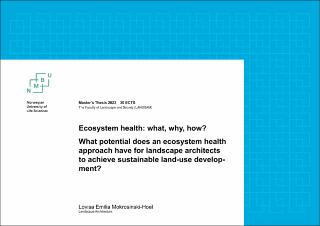| dc.description.abstract | One of the main challenges in today’s society is sustainable development of our land and landscapes for people, nature and the planet. This thesis will explore healthy eco- systems, what they are and why they need to be addressed (i.e. the potential they hold) and finally how we can achieve them. It will explore how landscape architects can uti- lise landscape ecological theory to improve the ecosystem health in their work, as one approach from one scientific field. Rather than a transformation in the planning field this thesis urges the need for a systematic transformation of how we see all systems on Earth as one with sub-systems alternating its dynamic. The thesis aims at becoming
a useful tool across disciplines to provide a new understanding of planet Earth and us. The objective is further to give a brief understanding of some important landscape ecological theories and principles (i.e. connectivity, corridors, barriers, heterogeneity, fragmentation) and make a deeper exploration of the sources and sinks for ecosystem health in our built landscapes.
Ecosystem health was in the thesis mainly oriented on people, nature and due to the scope of landscape architecture. The innovative approach of using landscape ecological theory enabled analyses of the function of different elements as sources and sinks (i.e. how they impact the ecosystem health dynamics). This was done for different scales (regional, landscape and site-scale) and contexts (land-use types in different matrixes: urban and sub-urban, residential and industrial). To see the potential of such an appro- ach for landscape architects a system was developed to grade and map the functioning of elements as sources and sinks, and the system was tested on four Norwegian ca- se-study sites as a joint assessment to map their ecosystem health. Further, final sug- gestions were demonstrated on how the dynamics of sources and sinks could be altered by simple interventions.
The system proved to be effective in mapping sources and sinks in sites on multiple scales and within the three systems. The joint assessment provided a holistic syner-
gy (scales and systems) and resulted in a possible prioritization of the ultimate good and bad solutions as in common sources and sinks across the systems. Trade-offs like missing out detail when mapping and limiting the study sites to built structures were addressed in the discussion. In the thesis a new understanding of ecosystem health was proposed, the potential of ecosystem health as a more applicable approach for landsca- pe architects in the strive towards sustainability was identified and landscape ecology proved valuable as a tool to achieve healthy ecosystems. More research and testing is required but I conclude that ecosystem health is a concept that holds great potential for achieving social and environmental sustainability for the future. | |
